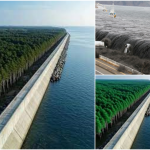The River of a New Beginning: The Muscogee Migration
- KimLoan
- September 29, 2025

Related Videos:
In the heart of the great green expanse that would one day be called the American Southeast, lived the Muscogee people. Their world was a vast network of rivers, streams, and fertile valleys, a land they had known for generations. Their confederacy of towns flourished across the territories of present-day Georgia, Alabama, and beyond. They were a sophisticated society, bound by ceremony, clan, and a deep reverence for the earth that sustained them. To the Europeans who would later arrive, they became known as the Creeks, a simple name given for the life-giving waterways that defined their homeland.

For centuries, their world was in balance. But by the 1500s, the winds of change began to blow from the east, carrying with them new peoples, new conflicts, and new pressures that the Muscogee had never known. The arrival of European explorers and settlers created a deep fracture in their way of life. Land that had always been communal was now being claimed by fences and forts. The old trade networks were disrupted, and conflicts with both the newcomers and neighboring tribes grew more frequent and bitter.

The pressure from the outside world also began to crack the unity within. The Muscogee Confederacy, a powerful alliance of towns, started to show signs of strain. A divide grew between the Upper Creeks in the north and the Lower Creeks to the south. Debates in the council circles grew tense; some argued for war and resistance, others for diplomacy and adaptation, and a growing number felt the only path to survival was to seek peace elsewhere.

For many among the Lower Creeks, the constant state of conflict felt like a slow poison. The dominance of the Upper Creek towns and the endless friction with outsiders left them yearning for a place where their children could grow up without the constant threat of battle. The soil itself seemed weary, the cornfields yielding less each season. They began to listen to the stories carried by hunters and traders—tales of a vast, sun-drenched land to the south, a place of lush wetlands and rich, dark earth perfect for planting corn, beans, and squash.

The decision to leave was not made lightly. To abandon the land of one’s ancestors, to leave behind the sacred mounds and the burial sites of generations, was a profound and heartbreaking choice. It was not an act of surrender, but an act of cultural preservation. They chose to move not in defeat, but in search of a future.

And so, the migration began. It was not a single, massive exodus, but a steady current of families and small groups, following the rivers south. They packed what they could carry: seeds for the next planting, tools, and the stories and traditions that defined who they were. It was a difficult journey, filled with uncertainty, but it was fueled by a powerful hope—the hope for new fields to plow and a new life lived in peace. They were searching for a place where the harmony they once knew could be planted again, like a seed in fertile ground, ready to grow into a new beginning.











